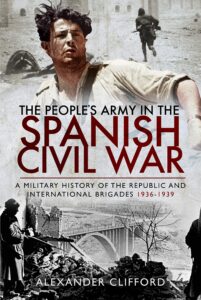Book Review: Two New Titles by Alexander Clifford

 Fighting for Spain: The International Brigades in the Civil War, 1936–1939, by Alexander Clifford. Pen and the Sword Military, 2020. 264pp.
Fighting for Spain: The International Brigades in the Civil War, 1936–1939, by Alexander Clifford. Pen and the Sword Military, 2020. 264pp.
The People’s Army in the Spanish Civil War: A Military History of the Republic and International Brigades, 1936-1939, by Alexander Clifford. Pen and the Sword Military, 2020. 414pp.
Few people will look back on 2020 with much fondness, but the year did at least provide some solace for those with an interest in the Spanish Civil War. Giles Tremlett’s comprehensive account of the International Brigades was published in November, followed shortly afterwards by Emmet O’Connor and Barry McLoughlin’s study of the Irish volunteers. Pipping them both to the finishing line, though, were two studies of the Republican Army by Alexander Clifford. Both are essentially military histories; the first, The People’s Army in the Spanish Civil War is a study of the army as a whole, while the second, Fighting for Spain, zooms in on the International Brigades. I imagine most readers will go for one or the other, rather than both, for there is inevitably some degree of overlap. Nonetheless, they are different books in terms of content and approach.
The People’s Army analyzes the role of the Republican army during three offensives in 1937: the battle of Brunete in July, the attack on Belchite during the Aragon offensive of the autumn, and the attack on the remote provincial capital of Teruel in the winter. For Clifford, the crucial exchange was at Brunete when, he suggests, “the war stood at a crossroads.” Clifford’s summary of what went wrong during the battle chimes with other studies, blaming “inadequate training, a poorly executed plan and a lack of tactical success and timing from commanders.” As a telling example of the shortcomings of the military commanders, the author recounts how the Republican General Valentine González, known as El Campesino, was passed a map of the Brunete battlefield: “Without looking at it, El Campesino spread it out on the table, face down, to serve as a tablecloth.” Clifford’s assessment of the subsequent fighting in Aragon and Teruel is just as critical. Both saw a disastrous loss of troops, matériel, and morale—a loss that Franco was able to capitalize on in the spring of 1938, fatally cleaving the Republic in two.
While The People’s Army limits itself to one year of the war, Fighting for Spain follows a more established format, tracing the experiences of the foreign volunteers through the course of the conflict. It begins with a familiar overview of the composition of the Brigades and what lay behind the volunteers’ decisions to go to Spain, before turning to an evaluation of their performance as soldiers. Clifford pushes back against some recent criticisms, reiterating that the 11 and 15 International Brigades in particular (together with General Lister’s famed Communist troops) were not only the finest units in the Republican Army but, at their best, equal to any of Franco’s troops. Yes, the Internationals suffered horrendous casualties—but this was not because they were ineffective or because they were sacrificed as “cannon fodder,” but because they were used as shock troops, thrown into the heart of battle.
Nonetheless, Clifford is surely right that the Republican People’s Army “will not go down in the annals of history as one of the world’s great fighting forces.” As Peter Carroll has observed, raw courage and a belief in the essential “rightness” of the cause “could not overcome inexperience, poor coordination, and superior military force.” Yet the Republicans managed to fight on for nearly three years, even though many observers had written off their chances during the first months of the war. Why did the Republic manage to hold on, when so much was against it? Franco’s conservative tactics and obsession with the capture and control of territory certainly played a part, but, Clifford argues, so did the fact that the Republican Army was actually a better fighting force than some historians believe. Despite all the obstacles it faced, he writes, “the Republic developed from being defended by peasants armed with swords and shotguns to having a regular fighting force capable of launching bold combined-arms offensives using modern military hardware and infiltration tactics.”
His insightful assessment of the Republic’s military capacity is likely to be of interest not just to military historians. His analysis of the shortcomings of the brigadas mixtas, on which the Republican army was based, is particularly illuminating. Nevertheless, both these volumes are essentially popular military history books, not academic studies. Though the author makes some use of memoir material (in English) and refers to the RGASPI files cited in Ronald Radosh’s controversial Spain Betrayed, he nonetheless relies primarily on secondary sources. The drawback with this approach is that errors or oversights in previous works can slip through unchallenged. In this instance, Clifford greatly overstates the number of Internationals shot for desertion. He also repeats the longstanding—and unfounded—assertion that the French Communist and Commander of the International Brigades, André Marty, was personally responsible for the execution of five hundred volunteers. Fortunately, he avoids some of the more obvious pitfalls, such as parroting the cold-war denunciation of Republican Spain as a Soviet puppet state. As he writes, “it is self-evident that the volunteers’ fight in Spain was an attempt to preserve Republican democracy rather than establish the dictatorship of the proletariat.”
While both books have their pros and cons, I suspect that Fighting for Spain will appeal more to members of ALBA. Although it’s less comprehensive than Giles Tremlett’s recent work, and less US- centered than the accounts by Peter Carroll and Adam Hochschild, Clifford manages to clearly and succinctly summarize the role of the International Brigades in Spain. In this, he is aided by numerous photos and maps and insets that zoom in on key individuals and weaponry. Readers interested in a more general background, on the other hand, may prefer The People’s Army.
Richard Baxell is an historian & lecturer and author of Unlikely Warriors. He is the Historical Consultant for the International Brigade Memorial Trust.













[…] review originally appeared in The Volunteer, August […]